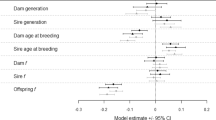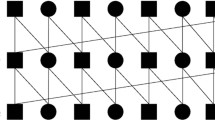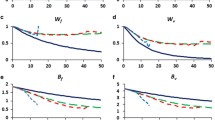Abstract
Many species require captive breeding to savethem from extinction, with reintroduction intothe wild being the eventual aim of mostprograms. Adaptation to captive environmentstypically results in reduced fitness under wildconditions. Consequently, unintentionaladaptation during captive breeding programs mayseriously compromise the success ofreintroduction programs. However, there islittle experimental evidence on the rate orextent of adaptation for captive populationsmaintained under benign captive conditions forextended periods of time. To investigate thedynamics of genetic adaptation to captivity,large captive populations of Drosophilamelanogaster were assessed for relativefitness under captive conditions for up to 87generations in captivity. Captive fitnessincreased to 3.33 times the initial fitnessover 87 generations. The pattern of adaptationwas curvilinear, with an exponential curveproviding the best fit. Fitness reached 25% ofits maximum within 6 generations, 50% within15 generations, 75% within 31 generations and95% within 67 generations. The model predictedthat the asymptotic level of fitness reachedwould be 3.38 times the initial fitness. Thus,very large genetic adaptations to captivity mayoccur under relatively benign captiveconditions. Captive populations destined forreintroduction need to be managed to minimisegenetic adaptation to captivity.
Similar content being viewed by others
References
Allard RW (1988) Genetic changes associated with the evolution of adaptedness in cultivated plants and their wild progenitors. J. Hered., 79, 225–238.
Allendorf FW (1993) Delay of adaptation to captive breeding by equalizing family sizes. Conserv. Biol., 7, 416–419.
Arnold SJ (1995) Monitoring quantitative genetic variation and evolution in captive populations. In: Population Management for Survival and Recovery: Analytical Methods and Strategies in Small Population Conservation (eds. Ballou JD, Gilpin M, Foose TJ), pp. 295–317. Columbia University Press, New York.
Ayala FJ (1965) Evolution and fitness in experimental populations of Drosophila serrata. Science, 150, 903–905.
Beck BB, Rapaport LG, Stanley-Price MR, Wilson AC (1994) Reintroduction of captive-born animals. In: Creative Conservation: Interactive Management of Wild and Captive Animals (eds. Olney PJS, Mace GM, Feistner ATC), pp. 265–286. Chapman and Hall, London.
Berejikian BA (1995) The effects of hatchery and wild ancestry and experience on the relative ability of steelhead trout fry (Oncorhynchus mykiss) to avoid a benthic predator. Can. J. Fish. Aquat. Sci., 52, 2476–2482.
Biggins DE, Godbey JL, Hanebury LR, Luce B, Marinari PE, Matchett MR, Vargas A (1998) The effect of rearing methods on survival of reintroduced black-footed ferrets. J. Wildl. Manage., 62, 643–653.
Briscoe DA, Malpica JM, Robertson A, Smith GJ, Frankham R, Banks RG, Barker JSF (1992) Rapid loss of genetic variation in large captive populations of Drosophila flies: Implications for the genetic management of captive populations. Conserv. Biol., 6, 416–425.
Bünger L, Herrendörfer G, Renne U (1990). Results of long term selection for growth traits in laboratory mice. In: Proceedings of the 4th World Congress on Genetic Applications in Livestock Production, Vol. 13, pp. 321–324.
Bush GL, Neck RW, Kitto GB (1976). Screwworm eradication: Inadvertent selection for noncompetitive ecotypes during mass rearing. Science, 193, 491–493.
Chilcote MW, Leider SA, Loch JJ (1986) Differential reproductive success of hatchery and wild summer-run steelhead under natural conditions. Trans. Am. Fish. Soc., 115, 727–735.
Clausen J, Keck DD, Heisey WM (1948) Experimental Studies on the Nature of Species. III Environmental Responses of Climatic Races of Achillea, Volume 581. Carnegie Institute ofWashington Publication, Washington.
Clifford SL, McGinnity P, Ferguson A (1998) Genetic changes in Atlantic salmon (Salmo salar) populations of north-west Irish rivers resulting from escapes of adult farm salmon. Can. J. Fish. Aquat. Sci., 55, 358–363.
Cowling SJ, Davies SJJF (1983) Status of Australian Birds with Special Reference to Captive Breeding. Victorian Department of Conservation, Forests and Lands, Wildlife Service Technical Report Series No.1, Melbourne, Australia.
Daniel C, Wood FS (1971) Fitting Equations to Data: Computer Analysis of Multifactor Data for Scientists and Engineers. John Wiley &; Sons, New York.
Darwin C (1868) The Variation of Animals and Plants under Domestication. The Johns Hopkins University Press, Baltimore and London.
Doyle RW, Herbinger C, Taggart CT, Lochmann S (1995) Use of DNA microsatellite polymorphism to analyse genetic correlations between hatchery and natural fitness. Am. Fish. Soc. Symp., 15, 205–211.
Dudley JW (1977) 76 generations of selection for oil and protein percentage in maize. In: Proceedings of the International Conference on Quantitative Genetics (eds. Pollak E, Kempthorne O, Bailey TB), pp. 459–473. Iowa State University Press, Ames, Iowa.
Dunham RA, Brummett RE, Ella MO, Smitherman RO (1990) Genotype-environment interactions for growth of blue, channel and hybrid catfish in ponds and cages at varying densities. Aquaculture, 85, 143–151.
Einum S, Fleming IA (1997) Genetic divergence and interactions in the wild among native, farmed and hybrid Atlantic salmon. J. Fish Biol., 50, 634–651.
Eisen EJ (1975) Population size and selection intensity effects on long-term selection response in mice. Genetics, 79, 305–323.
Enfield FD (1980) Long-term effects of selection to response. In: Selection Experiments in Laboratory and Domestic Animals (ed. Robertson A), pp. 69–86. Commonwealth Agricultural Bureau, Slough, UK.
Falconer DS, Mackay TFC (1996) Introduction to Quantitative Genetics, 4th edn. Longman, Harlow, England.
Fleming IA, Gross MT (1993) Breeding success of hatchery and wild coho salmon (Oncorhynchus kisutch) in competition. Ecol. Appl., 3, 230–245.
Fleming IA, Jonsson B, Gross MR, Lamberg A (1996) An experimental study of the reproductive behaviour and success of farmed and wild Atlantic salmon (Salmo salar). J. Appl. Ecol., 33, 893–905.
Fleming IA, Hindar K, Mjølnerød IB, Jonsson B, Balstad T, Lamberg A (2000) Lifetime success and interactions of farm salmon invading and native population. Proc. R. Soc. Lond. B., 267, 1517–1723.
Frankham R (1995a) Genetic management of captive populations for reintroduction. In: Reintroduction Biology of Australian and New Zealand Fauna (ed. Serena M), pp. 31–34. Surrey Beatty &; Sons, Chipping Norton, Australia.
Frankham R (1995b) Conservation genetics. Annu. Rev. Genet., 29, 305–327.
Frankham R (1996) Relationship between genetic diversity and population size in wildlife. Conserv. Biol., 10, 1500–1508.
Frankham R, Loebel DA (1992) Modelling problems in conservation genetics using captive Drosophila populations: Rapid genetic adaptation to captivity. Zoo Biol., 11, 333–342.
Frankham R, Ballou JD, Briscoe DA (2002) Introduction to Conservation Genetics. Cambridge University Press, Cambridge, UK.
Frankham R, Hemmer H, Ryder OA, Cothran EG, Soulé ME, Murray ND, Snyder M (1986) Selection in captive populations. Zoo Biol., 5, 127–138.
Frankham R, Manning H, Margan SH, Briscoe DA (2000) Does equalisation of family sizes reduce genetic adaptation to captivity? Animal Conservation, 3, 357–363.
Frankham R, Yoo BH, Sheldon BL (1988) Reproductive fitness and artificial selection in animal breeding: Culling on fitness prevents a decline in reproductive fitness in populations of Drosophila melanogaster selected for increased inebriation time. Theor. Appl. Genet., 76, 909–914.
Fraser JM (1981) Comparative survival and growth of planted wild, hybrid and domestic strains of brook trout (Salvelinus fontinalis) in Ontario lakes. Can. J. Fish. Aquat. Sci., 38, 1372–1384.
Fyfe RW (1978) Reintroducing endangered birds to the wild; a review. In: Endangered Birds: Management Techniques for Preserving Threatened Species (ed. Temple SA), pp. 323–329. University of Wisconsin Press, Madison.
Gilligan DM (2001) Conservation Genetics and Long-Term Survival: Testing Models Using Drosophila. PhD thesis, Macquarie University, Sydney, Australia.
Griffith B, Scott JM, Carpenter JW, Reed C (1989) Translocations as a species conservation tool: Status and strategy. Science, 245, 477–480.
Hammond K (1973) Population Size, selection Response and Variation in Quantitative Inheritance. PhD thesis, University of Sydney, Sydney, Australia.
Haque MN, Smith TR (1996) Reintroduction of Arabian sand gazelle Gazella subgutturosa maricai in Saudi Arabia. Biol. Conserv., 76, 203–207.
Hill WG (2000) Maintenance of quantitative genetic variation in animal breeding programmes. Livestock Prod. Sci., 63, 99–109.
Hjort RC, Achreck CB (1982) Phenotypic differences among stocks of hatchery and wild coho salmon, Oncorhynchus kisutch, in Oregon, Washington, and California. U.S. National Marine Fisheries Service Fishery Bulletin, 80, 105–119.
IUCN (1987) IUCN Policy Statement on Captive Breeding. IUCN, Gland, Switzerland.
Johnsson JI, Abrahams MV (1991) Interbreeding with domestic strain increases foraging under threat of predation in juvenile steelhead trout (Oncorhynchus mykiss): An experimental study. Can. J. Fish. Aquat. Sci., 48, 243–247.
Johnsson JI, Petersson E, Jönsson E, Björnsson BT, Järvi T (1996) Domestication and growth hormone alter antipredator behaviour and growth patterns in juvenile brown trout, Salmo trutta. Can. J. Fish. Aquat. Sci., 53, 1546–1554.
Jones LP, Frankham R, Barker JSF (1968) The effects of population size and selection intensity in selection for a quantitative character in Drosophila. II. Long-term response to selection. Genet. Res. Camb., 12, 249–266.
Jungen H, Hartl DL (1979) Average fitness of populations of Drosophila melanogaster as estimated using compound-autosome strains. Evolution, 33, 359–370.
King HD (1939) Life processes in gray Norway rats during fourteen years in captivity. Amer. Anat. Mem., 17, 1–77.
Kohane MJ, Parsons PA (1988) Domestication. Evolutionary change under stress. Evol. Biol., 23, 31–38.
Lachance S, Magnan P (1990) Performance of domestic, hybrid and wild strains of brook trout (Salvelinus fontinalis) after stocking: Tthe impact of intra-and interspecific competition. Can. J. Fish. Aquat. Sci., 47, 2278–2284.
Lande R (1995) Breeding plans for small populations based on the dynamics of quantitative genetic variance. In: Population Management for Survival and Recovery: Analytical Methods and Strategies in Small Population Conservation (eds. Ballou, JD, Gilpin M, Foose TJ), pp. 318–340. Columbia University Press, New York.
Latter BDH, Mulley JC (1995) Genetic adaptation to captivity and inbreeding depression in small laboratory populations of Drosophila melanogaster. Genetics, 139, 255–266.
Leider SA, Hulett PL, Loch JJ, Chilcote MW(1990) Electrophoretic comparison of the reproductive success of naturally spawning transplanted and wild steelhead trout through the returning adult stage. Aquaculture, 88, 239–252.
Letty J, Marchandeau S, Clobert J, Aubineau J (2000) Improving translocation success: An experimental study of anti-stress treatment and release method for wild rabbits. Animal Conservation, 3, 211–219.
Lindsley DL, Zimm GG (1992) The Genome of Drosophila melanogaster. Academic Press, San Diego.
Margan SH, Nurthen RK, Montgomery ME, Woodworth LM, Lowe EH, Briscoe DA, Frankham R (1998) Single large or several small? Population fragmentation in the captive management of endangered species. Zoo Biol., 17, 467–480.
Maynard DJ, Flagg TA, Mahken CVW (1995) A review of seminatural culture strategies for enhancing post-release survival of anadromous salmonids. In: Uses and Effects of Cultured Fishes in Aquatic Ecosystems (eds. Schramm Jr HL, Piper RG), pp. 307–314. American Fisheries Society, Symposium 15, Bethesda, Maryland, USA.
McGinnity P, Stone C, Taggart JB, Cooke D, Cotter D, Hynes R, McCamley C, Cross T, Ferguson A (1997) Genetic impact of escaped farmed Atlantic salmon (Salmo salar L.) on native populations: Use of DNA profiling to assess freshwater performance of wild, farmed and hybrid progeny in a natural river environment. ICES J. Mar. Sci., 54, 998–1008.
Moav R, Hulata G, Wohlfarth G (1975) Genetic differences between the Chinese and European races of the common carp, 1: Analysis of genotype-environment interactions for growth rate. Heredity, 34, 323–340.
Montgomery ME, Woodworth LM, Nurthen RK, Gilligan DM, Briscoe DA, Frankham R (2000) Relationship between population size and loss of genetic diversity: Comparison of experimental results with theoretical predictions. Animal Conservation, 1, 33–43.
Moore DE III, Smith R (1991) The red wolf as a model for carnivore re-introductions. Symp. Zool. Soc. Lond., 62, 263–278.
Moyle PB (1969) Comparative behaviour of young brook trout of domestic and wild origin. Prog. Fish-Cult., 31, 51–59.
Myers D, Sabath MD (1980) Genetic and phenotypic variability, genetic variance, and the success of establishment of insect introductions for the biological control of weeds. In: Proceedings of the V International Symposium on Biological Control of Weeds, pp. 91–102. Brisbane, Australia.
Price EO (1984) Behavioural aspects of animal domestication. Q. Rev. Biol., 59, 1–32.
Reisenbichler RR, Brown G (1995) Is genetic change from hatchery rearing of anadromous fish really a problem? Am. Fish. Soc. Symp., 15, 578–579.
Reisenbichler RR, McIntyre JD (1977) Genetic differences in growth and survival of juvenile hatchery and wild steelhead trout. Journal of the Fisheries Research Board of Canada, 34, 123–128.
Reisenbichler RR, Rubin SP (1999). Genetic changes from artificial propagation of Pacific salmon affect the productivity and viability of supplemented populations. ICES J. Mar. Sci., 56, 459–466.
Robertson A (1960). A theory of limits in artificial selection. Pro. Roy. Soc. Lond. B, 153, 234–249.
Robertson A (1980) Selection Experiments in Laboratory and Domestic Animals. Commonwealth Agricultural Bureau, Slough, UK.
Saltz D, Rubenstein DI (1995) Population dynamics of a reintroduced Asiatic wild ass (Equus hemionus) herd. Ecol. Appl., 5, 327–335.
Sanz V, Grajal A (1998) Successful reintroduction of captiveraised yellow-shouldered Amazon parrots on Margarita Island, Venezuela. Conserv. Biol., 12, 430–441.
Serena M (1994) Reintroduction Biology of Australian and New Zealand Fauna. Surrey Beatty &; Sons, Chipping Norton, Australia.
Silvela L, Rodger R, Barrera A, Alexander DE (1989) Effects of selection intensity and population size on percent oil in maize, Zea mays. Theo. Appl. Genet., 78, 298–403.
Soulé ME (1976) Allozyme variation, its determinants in space and time. In: Molecular Evolution (ed. Ayala FJ), pp. 60–77. Sinauer, Sunderland, Massachusetts.
Soulé ME, Gilpin M, Conway W, Foose T (1986) The millenium ark: How long a voyage, how many staterooms, how many passengers? Zoo Biol., 5, 101–113.
Stanley-Price MR (1989) Animal Re-Introductions: The Arabian Oryx in Oman. Cambridge University Press, Cambridge.
Swain DP, Riddell BE (1990) Variation in agonistic behaviour between newly emerged juveniles from hatchery and wild populations of coho salmon (Oncorhynchus kisutch). Can. J. Fish. Aquat. Sci., 47, 566–571.
Turesson G (1925). The plant species in relation to habitat and climate. Hereditas, 6, 147–236.
van Heezik Y, Seddon PJ, Maloney RF (1999) Helping reintroduced houbara bustards avoid predation: effective anti-predator training and the predictive value of pre-release behaviour. Animal Conservation, 2, 155–163.
Vasquez CG, Bohren BB (1982) Population size as a factor in response to selection for eight week body weight in white leghorns. Poult. Sci., 61, 1273–1278.
Weber KE (1990) Increased selection response in larger populations. I. Selection for wing-tip height in Drosophila melanogaster at three population sizes. Genetics, 125, 579–584.
Weber KE (1996) Large genetic change at small fitness cost in large populations of Drosophila melanogaster selected for wind tunnel flight: Rethinking fitness surfaces. Genetics, 144, 205–213.
Weber KE, Diggins LT (1990) Increased selection response in larger populations. II. Selection for ethanol vapor resistance in Drosophila melanogaster at two population sizes. Genetics, 125, 585–597.
Weiss S, Schmutz S (1999) Performance of hatchery reared brown trout and their effects on wild fish in two small Austrian streams. Trans. Am. Fish. Soc., 128, 302–316.
Wiley RW, Whaley RA, Satake JB, Fowden M(1993) An evaluation of the potential for training trout in hatcheries to increase poststocking survival in streams. N. Am. J. Fish. Manage., 13, 171–177.
Wohlfarth GW, Moav R, Hulata G (1986) Genetic differences between Chinese and European races of common carp, 5. Differential adaptations to manure and artificial feeds. Theo. Appl. Genet., 2, 88–97.
Wolf CM, Griffith B, Reed C, Temple SA (1996) Avian and mammalian translocations: Update and reanalysis of 1987 survey data. Conserv. Biol., 10, 1142–1154.
Woodworth, LM (1996). Population Size in Captive Breeding Programs. PhD thesis, Macquarie University, Sydney, Australia.
Woodworth LM, Montgomery ME, Briscoe DA, Frankham R (2002) Rapid genetic deterioration in captive populations: Causes and conservation implications. Conserv. Genet. [in press].
Author information
Authors and Affiliations
Corresponding author
Rights and permissions
About this article
Cite this article
Gilligan, D.M., Frankham, R. Dynamics of genetic adaptation to captivity. Conservation Genetics 4, 189–197 (2003). https://doi.org/10.1023/A:1023391905158
Issue Date:
DOI: https://doi.org/10.1023/A:1023391905158




